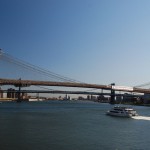Brooklyn Bridge (New York, USA)
The Brooklyn Bridge, one of the oldest suspension bridges in US, spans 5 989 feet (1825 meters) of the East River, connecting two boroughs of New York City – Manhattan and Brooklyn. At the time of its completion, it was the longest suspension bridge in the world and the first steel-wire suspension bridge. Originally, the bridge was called the New York and Brooklyn Bridge. The Brooklyn Bridge became its officially accepted name after the city government adopted it in 1915. From the day of its opening, the bridge became one of the symbols of New York City. In 1964, it was designated a National Historic Landmark.
Construction began on January 3 of 1870. The Brooklyn Bridge was finished thirteen years later and was opened for traffic on May 24 of 1883. On the first day close to 1,800 vehicles and 150.300 people in total crossed it. The main span of the bridge across the East River is 1,595 feet and 6 inches long (486.3 meters). The bridge’s cost was 15.1 million US dollars and around 27 people died during its construction. One week after the opening, on May 30, a rumour that the bridge is going to collapse caused a stampede, in which 12 people fell and were crushed by the crowd.
At the time of its opening, it was the longest suspension bridge; it was 50 % longer, than any other existing bridge. Besides, its towers for a few years were the highest constructions in Western Hemisphere. From 1980s, the bridge was floodlit at nights to emphasize its architectural characteristics. The bridge is built of limestone, granite and Rosendale cement. The architectural style of the bridge is neo-Gothic.
The bridge was designed by John Augustus Roebling in Trenton, New Jersey. Earlier Roebling designed and built other suspension bridges, such as Roebling’s Delaware Aqueduct in Lackawaxen, Pennsylvania, the John A. Roebling Suspension Bridge in Cincinnati, Ohio and Waco Suspension Bridge in Waco, Texas.
When the bridge was built, the aerodynamics of bridge building had not been worked out and its role in the surviving characteristics had not been made clear. Bridges were not tested in wind tunnels until the 1950s. So chance and good luck had their input in the design and construction of this bridge, for the open truss structure supporting the deck is by its nature less subject to aerodynamic problems. Roebling designed a bridge and truss system that was six times as strong as he thought it needed to be. Because of this, the Brooklyn Bridge is still standing when many of the bridges built around the same time have vanished into history and been replaced. Diagonal cables were installed from the towers to the deck to stiffen the bridge. This reinforcement turned out to be unnecessary, but they have been kept until now, for they add to the bridge its specific charm.
In 2006, a Cold War era bunker was found by city workers near the East River shoreline of Manhattan’s Lower East Side. Its entrance was hidden within the masonry anchorage on the Manhattan side. Considerable supplies were found in the hide – 350 tin cans with biscuits, air-cleaning machinery, blankets, and first aid kits. The bunker, hidden in one of the towers, still contained emergency supplies that were being stored for a potential nuclear attack by the Soviet Union.
The Brooklyn Bridge has a wide pedestrian walkway open to walkers and cyclists, in the center of the bridge and higher than the automobile lanes. During transit strikes by the Transport Workers Union in 1980 and 2005, the bridge was used by people commuting to work as the most convenient way to get to the center of New York City.
Contemporaries marveled at what technology was capable of and the bridge became a symbol of the optimism of the time. John Perry Barlow wrote in the late 20th century of man’s “literal and genuinely religious leap of faith into the future” embodied in the Brooklyn Bridge … “the Brooklyn Bridge required of its builders faith in their ability to control technology.”

